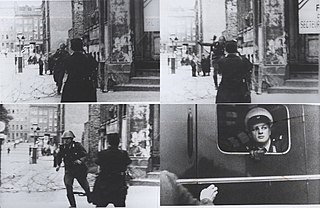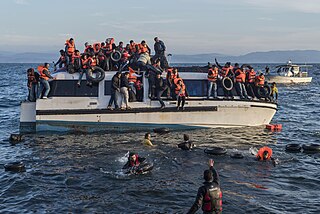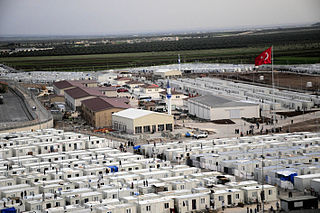Migration and Asylum Project (M.A.P.), formerly known as the Ara Legal Initiative, is a refugee legal aid centre based in New Delhi, India. [1] It provides legal aid and counselling to asylum seekers and refugees in India. [2]
Migration and Asylum Project (M.A.P.), formerly known as the Ara Legal Initiative, is a refugee legal aid centre based in New Delhi, India. [1] It provides legal aid and counselling to asylum seekers and refugees in India. [2]
M.A.P was started as The Ara Trust’s pilot programme on 20 February 2013. It was set up primarily to introduce the concept of legal representation in UNHCR’s asylum process and to ensure that every refugee in India was able to realise their right to legal assistance. The idea was to make the system more transparent and accountable and thereby bring them in line with India’s democratic ethos.
The initiative was conceived by Roshni Shanker, the organisation’s founder, when she was working as a lawyer with UNHCR’s field offices, assessing asylum claims from conflict-affected countries. It was during this time that she came across some of the most inspiring stories of human spirit and endurance in the face of insurmountable hurdles. She gained intimate knowledge of what it was to rebuild one’s life in an alien land without knowing the local language and not being able to fall back on familiar support systems.
Roshni also realised that traditional humanitarian interventions often fail to recognise legal assistance as being fundamental to refugees’ post-conflict recovery and rehabilitation. In addition, given that the overwhelming majority of refugees are women and girls, who are disproportionately affected by conflict and remain highly vulnerable even in the country of asylum, she identified the need for specially tailored assistance for this population. She however understood that these gaps can be better addressed at grassroots level by organisations familiar with the local context. Since India had no such independent organisation at the time, Roshni decided to leave the UN and returned to start M.A.P.[ citation needed ]
Today, M.A.P is one of the foremost advocates for refugees in the region and uses the law as an effective tool to expand the legal protection space for this group. It continues to evolve as an organisation constantly innovating to address the growing needs of this population in light of the local and international context. For example, in the background of India’s move towards an inclusive economic order, M.A.P is the first organisation to run an initiative to assimilate refugees within this new financial landscape. [3]
India is not a party to the Convention Relating to the Status of Refugees. [4] However, UNHCR in India conducts Refugee Status Determination (RSD) procedures, [5] which starts with registration of individual asylum-seekers. Following registration, UNHCR conducts interviews with each individual asylum-seeker to assess his/her claim to international protection as a refugee.[ citation needed ]
In 2013, M.A.P entered into a Memorandum of Understanding (MoU) with UNHCR India to provide legal aid to asylum seekers for RSD interviews, and requiring UNHCR to provide a detailed rejected letter for all cases. [2] M.A.P. is an intermediary between refugees and UNHCR and has been offering legal assistance and representation to asylum seekers from countries including Afghanistan, Somalia, and Sudan since 2013. [2] [6]
In 2016, this model was recognised as a best practice for replication by other countries in the region by the UNHCR Headquarters. [2]
In September 2015, M.A.P published a report on "Refugee Protection in India: Access to Economic and Social Rights", which was fully funded by UNHCR India. [7] In 2015, M.A.P assisted a sitting Member of Parliament, Shashi Tharoor with the drafting of a domestic asylum law, which was introduced in the Indian Parliament as a private members Bill. [8] [9] Members from the legal team of the organisation also contribute regularly to editorials on contemporary changes relating to refugees in India. [10] [11] [12]
In January 2019, M.A.P. organised an exhibition titled "Passage to Asylum". [13] Through a series of rooms, the exhibition depicted various stages of a refugee's life starting from their home to the asylum process they undergo in a different country. [14] In July 2018, the organisation launched a livelihood initiative Atiqa in association with Dastkar for Afghani refugee women in India, who are using their skills in traditional embroidery. [6]

The United Nations High Commissioner for Refugees (UNHCR) is a United Nations agency mandated to aid and protect refugees, forcibly displaced communities, and stateless people, and to assist in their voluntary repatriation, local integration or resettlement to a third country. It is headquartered in Geneva, Switzerland, with over 17,300 staff working in 135 countries.

A refugee, conventionally speaking, is a person who has lost the protection of his or her country of origin and who cannot or is unwilling to return there due to well-founded fear of persecution. Such a person may be called an asylum seeker until granted refugee status by the contracting state or the United Nations High Commissioner for Refugees (UNHCR) if they formally make a claim for asylum.
An asylum seeker is a person who leaves their country of residence, enters another country and applies for asylum in that other country. An asylum seeker is an immigrant who has been forcibly displaced and might have fled their home country because of war or other factors harming them or their family. If their case is accepted, they become considered a refugee. The terms asylum seeker, refugee and illegal immigrant are often confused.

An internally displaced person (IDP) is someone who is forced to leave their home but who remains within their country's borders. They are often referred to as refugees, although they do not fall within the legal definitions of a refugee.

Forced displacement is an involuntary or coerced movement of a person or people away from their home or home region. The UNHCR defines 'forced displacement' as follows: displaced "as a result of persecution, conflict, generalized violence or human rights violations".

The Pacific Solution is the name given to the Government of Australia's policy of transporting asylum seekers to detention centres on island nations in the Pacific Ocean, rather than allowing them to land on the Australian mainland. Initially implemented from 2001 to 2007, it had bipartisan support from the Coalition and Labor opposition at the time. The Pacific Solution consisted of three central strategies:
Refugee law is the branch of international law which deals with the rights and duties states have vis-a-vis refugees. There are differences of opinion among international law scholars as to the relationship between refugee law and international human rights law or humanitarian law.
Non-refoulement is a fundamental principle of international law that forbids a country receiving asylum seekers from returning them to a country in which they would be in likely danger of persecution based on "race, religion, nationality, membership of a particular social group or political opinion". Unlike political asylum, which applies to those who can prove a well-grounded fear of persecution based on certain category of persons, non-refoulement refers to the generic repatriation of people, including refugees into war zones and other disaster locales. It is a principle of customary international law, as it applies even to states that are not parties to the 1951 Convention Relating to the Status of Refugees or its 1967 Protocol. It is also a principle of the trucial law of nations.

The United States recognizes the right of asylum for refugees as specified by international and federal law. A specified number of legally defined refugees who are granted refugee status outside the United States are annually admitted under 8 U.S.C. § 1157 for firm resettlement. Other people enter the United States as aliens either lawfully or unlawfully and apply for asylum under section 1158.
Refugees in Hong Kong have formed historic waves arriving in the city due to wars in the region and Hong Kong's historical role as a trading and transit entrepôt. More recently those seeking asylum or protection based on torture claims are a fast growing part of the city's population, increasing since 2004 due to changes in the legal system for considering asylum and torture claims mandated by local courts.
The Russian Federation's Law on Refugees defines who is a refugee for purposes of obtaining asylum in the country. The Law defines a refugee as a "person who is outside his/her country of nationality or habitual residence; has a well-founded fear of persecution because of his/her race, religion, nationality, membership in a particular social group or political opinion; and is unable or unwilling to avail himself/herself of the protection of that country, or to return there, for fear of persecution. Upon receiving an asylum seeker's application, the Russian Migration Service determines whether the asylum seeker meets the legislative definition of a "refugee" and should be granted asylum.
The United Nations High Commissioner for Refugees Representation in Cyprus is an office of the United Nations High Commissioner for Refugees (UNHCR) opened in August 1974 upon the request of the Government of Cyprus and the Secretary-General of the United Nations. UNHCR Representation in Cyprus was designated as Coordinator of the United Nations Humanitarian Assistance for Cyprus. UNHCR was also responsible upon the request of the Cyprus Government to examine applications for refugee status.
The Gateway Protection Programme was a refugee resettlement scheme operated by the Government of the United Kingdom in partnership with the United Nations High Commissioner for Refugees (UNHCR) and co-funded by the European Union (EU), offering a legal route for a quota of UNHCR-identified refugees to be resettled in the UK. Following a proposal by the British Home Secretary, David Blunkett, in October 2001, the legal basis was established by the Nationality, Immigration and Asylum Act 2002 and the programme itself launched in March 2004. The programme enjoyed broad support from the UK's main political parties.

Sudanese refugees in Israel refers to citizens of Sudan who have sought refuge in Israel due to military conflict at home, and to those who moved there illegally as migrant workers. In 2008, there were 4,000 Sudanese in Israel, 1,200 from Darfur and the remainder Christians from South Sudan. The majority entered through the Israeli-Egypt border. Most live in Tel Aviv, Arad, Eilat and Bnei Brak.
Sudanese refugees are persons originating from the country of Sudan, but seeking refuge outside the borders of their native country. In recent history, Sudan has been the stage for prolonged conflicts and civil wars, as well as environmental changes, namely desertification. These forces have resulted not only in violence and famine but also the forced migration of large numbers of the Sudanese population, both inside and outside the country's borders. Given the expansive geographic territory of Sudan, and the regional and ethnic tensions and conflicts, much of the forced migration in Sudan has been internal. Yet, these populations are not immune to similar issues that typically accompany refugeedom, including economic hardship and providing themselves and their families with sustenance and basic needs. With the creation of a South Sudanese state, questions surrounding southern Sudanese IDPs may become questions of South Sudanese refugees.
Refugees of the Syrian Civil War are citizens and permanent residents of Syria who have fled the country throughout the Syrian Civil War. The pre-war population of the Syrian Arab Republic was estimated at 22 million (2017), including permanent residents. Of that number, the United Nations (UN) identified 13.5 million (2016) as displaced persons, requiring humanitarian assistance. Of these, since the start of the Syrian Civil War in 2011 more than six million (2016) were internally displaced, and around five million (2016) had crossed into other countries, seeking asylum or placed in Syrian refugee camps worldwide. It is often described as one of the largest refugee crises in history.

Voluntary return or voluntary repatriation is usually the return of an illegal immigrant or over-stayer, a rejected asylum seeker, a refugee or displaced person, or an unaccompanied minor; sometimes it is the emigration of a second-generation immigrant who makes an autonomous decision to return to their ethnic homeland when they are unable or unwilling to remain in the host country.

The head office of UNHCR's mission in India is located in Delhi, with a field office in Chennai. Actor John Abraham is the Goodwill ambassador for UNHCR in India. The current chief of mission is Oscar Mundia. UNHCR won the Indira Gandhi Prize for Peace, Disarmament and Development in 2015. UNHCR was awarded the Mother Teresa Award for Social Justice by the Harmony Foundation, Mumbai.

Turkey's migrant crisis, sometimes referred to as Turkey's refugee crisis, was a period during the 2010s characterized by high numbers of people migrating to Turkey to take up residence in the country. Turkey received the highest number of registered refugees of any country or territory every year from 2014 to 2019, and had the world's largest refugee population according to the United Nations High Commissioner for Refugees (UNHCR). The majority were refugees of the Syrian Civil War, numbering 3,591,892 as of June 2020. In 2018 the UNHCR reported that Turkey hosted 63.4% of all the "registered Syrian refugees."
Migration and asylum policy of the European Union - is a policy within the area of freedom, security and justice, established to develop and harmonise principles and measures used by member countries of the European Union to regulate migration processes and to manage issues concerning asylum and refugee status in the European Union, in particular in the Schengen Area.